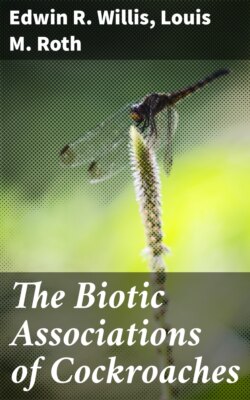Читать книгу The Biotic Associations of Cockroaches - Edwin R. Willis - Страница 81
На сайте Литреса книга снята с продажи.
DESERT HABITATS
ОглавлениеTable of Contents
There is relatively little ecological information about cockroaches that live in deserts, even though certain species, notably Polyphaga aegyptiaca, have long been known to inhabit arid zones. In fact, so little is known about the ecology of arid-zone insects in general that it is more a subject for research than for review (Pradhan, 1957). In their account of the cockroaches of Northern Kenya and Jubaland, Kevan and Chopard (1954) describe in some detail the vegetational areas of this arid desert or semidesert country, which averages only about 10 inches of rain per year. The other sources that are cited below contain very little more biological information than the abstracted material that is given under each species.
Nearly all the Polyphaginae are said to be marked xerophiles whose distribution coincides with that of the deserts (Bei-Bienko, 1950). With the exception of Arenivaga floridana, the species of Polyphaginae in the United States all occur in the Southwest, where they are (with a few exceptions) the only cockroaches that inhabit the desert regions proper (Hebard, 1917). The Polyphaginae reach their greatest diversity in the deserts of Northern Africa and Anterior and South-Central Asia (Bei-Bienko, 1950). Some of the desert-inhabiting species have also been found under nondesert conditions. This only further exemplifies the plasticity of cockroaches in adapting to different environments.
The ability of desert insects to live under what appear to be extremely unfavorable conditions has been abundantly illustrated by Pradhan (1957). Uvarov (1954) has pointed out that a desert "covers a great variety of landscapes, which provide desert animals with a wide range of habitats, some of them offering very favorable conditions for life." Pradhan (1957) stated that many desert animals avoid the extremes of desert climates by choosing suitable microclimates for diurnal resting places, that a permanent or temporary underground existence is very common among insects in arid zones, and that many nocturnal Orthoptera burrow into the soil or hide under stones where temperatures are lower. For example, the type of Parcoblatta desertae was found under a boulder on the bare desert (Rehn and Hebard, 1909).
Symbiosis with burrowing animals is another solution to the problem of existence in the desert; in fact, symbiosis is a mode of life adopted by nearly half of the desert cockroaches about which we have any information. Vlasov and Miram (1937) found Polyphaga indica, Polyphaga saussurei, and Arenivaga roseni in the burrows of rodents and desert turtles. In the desert regions of Arizona, females of Arenivaga erratica were found commonly in burrows of the kangaroo rat (Vorhies and Taylor, 1922) and in dens of wood rats and ground squirrels (Ball et al., 1942). Arenivaga apacha and Arenivaga bolliana have also been found inhabiting the nests of wood rats (Hebard, 1917; 1943a). Bei-Bienko (1950) has suggested that the adaptation of desert-inhabiting cockroaches to rodent burrows might enable these insects to survive in the severe climatic conditions of deserts in summer.
Under desert conditions in southern Arizona, the relative humidity outside of the burrows of the kangaroo rat is 1 to 15 percent during the day and 15 to 40 percent at night; but inside the burrows the relative humidity is 30 to 50 percent, and the temperature, even during the day, is below 30° C. (Schmidt-Nielsen, 1949). Thus by living in rodent burrows during the day and going outside at night, the desert cockroaches could avail themselves of the most favorable microclimates obtainable. Presumably whatever food these insects eat provides them with sufficient water to enable them to survive under desert conditions. Bodenheimer (1953) has suggested that the extent of utilization of dew, which is sometimes heavy in the desert, should be investigated; he stated that tenebrionid beetles have been seen in the early morning eating dry [dead?] herbs that were still wet with dew. It is obvious that there is a need for additional detailed information without which we can only guess about the ecology of desert cockroaches.
In the following list we have cited only those species that were stated to have been found under desert conditions. Undoubtedly, related species that have been taken in similar localities are also desert-inhabiting forms, as, for example, other species of Arenivaga that were collected in Texas by Hebard (1943a). In the absence of specific information linking such other species with deserts, we have arbitrarily relegated those forms to the section on outdoor habitats. In addition to the species listed below, desert cockroaches are said to be found in the following genera: Anisogamia, Mononychoblatta, and Nymphytria (Chopard, 1938).
